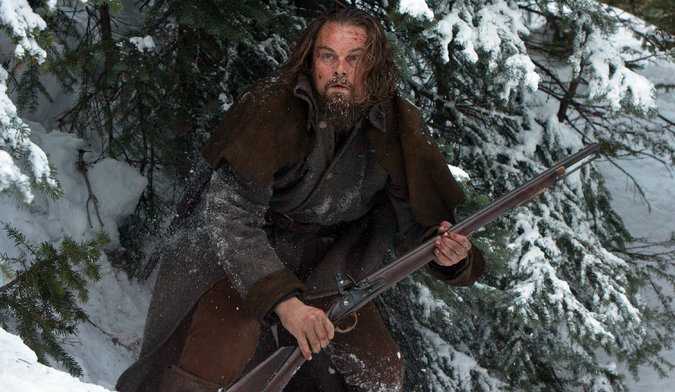Movie Review: ‘The Revenant’

(Courtesy of 20th Century Fox)
By Tridib Biswas
Jan. 5, 2016 12:12 a.m.
An unsuspecting fur trapper is pierced between the eyes by an arrow and crumples to the floor. In the background, dozens of other trappers are shown suffering the same fate. Alejandro González Iñárritu’s “The Revenant” makes its theme clear from the very beginning: The harsh snow-covered American frontier brings out extraordinary endurance, but instigates terrible brutality.
A team of fur trappers captained by Andrew Henry (Domnhall Gleeson) traverses the foreboding American wilderness and tries to survive against marauding Native American tribes. In a scene as unsparing as the Normandy landing in “Saving Private Ryan,” a raiding group of Native Americans kill all but ten members of Henry’s trapping team. Among the survivors are Henry himself and Hugh Glass (Leonardo DiCaprio), the team’s navigator, travelling with his half-Native American son Hawk (Forrest Goodluck). From then on, the movie chronicles Glass’ quest for revenge against and his struggle to survive in the wilderness.
From a filmmaking perspective, “The Revenant” is nothing short of remarkable. Iñárritu captures a naturally-lit and enormous frontier. The barren landscape of 19th-century America is navigated with depth and skill by award-winning cinematographer Emmanuel Lubezki, who presents wide vistas and long tracking shots, all of which were shot on location.
With grit and resolve, Glass toils through the frontier and the movie continues to show us scenes of extraordinary endurance. Given how much the plot relies on the cruelty of nature and how almost every shot is beautiful enough to grace the cover of a National Geographic, Iñárritu juxtaposes the frozen nature of the frontier with the emotions of the story, especially through flashbacks of Glass’ wife. The frontier transforms into its own character that has raw power over the actions of the men in the film.
Along with nature, Iñárritu also often frames violence, keeping the camera unnervingly close and steady for the fight scenes rather than following the action movie trend of a shaky camera. The blood and guts shown on screen accentuate the unforgiving nature of the wilderness and serve to let the audience feel the intensity of Glass’ trauma.
The bulk of “The Revenant” presents a struggling Glass moving into increasingly hostile environments as autumn becomes winter. The intense violence shown is undoubtedly an artistic choice and serves as commentary on what man becomes in the wild. With the length of the movie and dialogue being as sparse as it is, scenes of a stoic Glass navigating nature are punctuated with scenes of shocking violence which keep the movie thudding along. None of the violence, however, is too much – all of it is the reality of the life that these characters lead.
The director’s penchant for extensive framing of the film’s environment adds considerably to the movie’s length without strengthening the story. While “The Revenant” always provides impressive visuals, it lacks emotional focus at times. The relationship between Glass and his son Hawk is never explored, and the small amount of onscreen interaction the two have serves to set Hawk up as a pig for slaughter because his death feels almost inevitable from the very beginning.
The real pathos in the movie comes from Leonardo DiCaprio, whose pain is palpable. DiCaprio’s character has very few scenes with dialogue, yet through only guttural screams and heavy breathing, DiCaprio is able to show the state of a man who is pushed to the brink both physically and mentally. The grueling process of filming “The Revenant” comes through and DiCaprio makes Hugh Glass’ suffering seem like his own.
The power of the film is its ability to take the audience on a vivid journey of endurance and savagery. Despite its flaws, it is without doubt a visionary piece of work.
– Tridib Biswas


